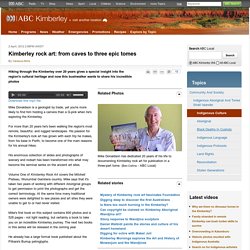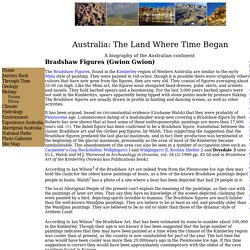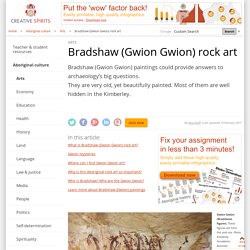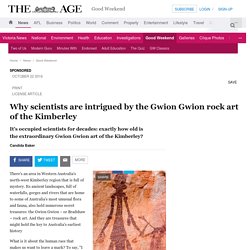

Bradshaw Paintings / Gwion Gwion Gallery. The remote coastline of north western Australia was probably the first landing site on this continent, as groups of our early ancestors crossed by boat from Timor up to 60,000 years ago.

The Journey of Mankind Genetic Map can prove when this event occurred, but it can only point to what these early settlers did on reaching the Kimberley region; at some point, they began to decorate the red sandstone rocks with exquisite and detailed rock art, now referred to as the Bradshaw paintings, or Gwion Gwion. Bradshaw aboriginal rock drawings. The Bradshaw Paintings - Australian Rock Art Archive.
Kimberley rock art: from caves to three epic tomes - ABC Kimberley WA - Australian Broadcasting Corporation. Mike Donaldson is a geologist by trade, yet you're more likely to find him holding a camera than a G-pick when he's exploring the Kimberley.

For more than 20 years he's been walking the region's most remote, beautiful, and rugged landscapes. His passion for the Kimberley's rock art has grown with each trip he makes, from his base in Perth, to become one of the main reasons for his annual hikes. His enormous collection of slides and photographs of scenary and rockart has been transformed into what may become the seminal series on the ancient art sites. Volume One of Kimberley Rock Art covers the Mitchell Plateau, Wunumbal Gambera country. Mike says that it's taken two years of working with different Aboriginal groups to get permission to print the photographs and get the correct terminology. Mike's first book on this subject contains 600 photos and is 528 pages - not light reading, but certainly a book to take you on an incredible Kimberley journey. Bradshaw Art. Bradshaw Figures (Gwion Gwion) The Bradshaw Figures, found in the Kimberley region of Western Australia are similar to the early Mimi style of painting.

They were painted in red ochre, though it is possible there were originally others colours that have now gone from the figures, they are very old. They consist of figures averaging about 35-30 cm high. Like the Mimi art, the figures wear elongated head-dresses, pubic skirts, and armlets and tassels. They hold barbed spears and a boomerang. It has been argued, based on circumstantial evidence (Grahame Walsh) that they were probably of Pleistocene age. Bradshaw (Gwion Gwion) rock art. Gwion Gwion (Bradshaw) figures.

These figures are from the sash era. Photo: Kimberley Foundation Australia What is Bradshaw (Gwion Gwion) rock art? Bradshaw, or Gwion rock art, are sophisticated paintings dotted across approximately 100,000 sites spread over an area of 50,000 square kilometres [3] (about the size of Costa Rica in Central America, or Slovakia in Europe). They are thought to be at least 17,000, perhaps more than 25,000 years old. The ancient Bradshaw rock paintings are very different to any other Aboriginal rock art found in Australia. Some of the paintings are small, others up to 5 metres long and 3 metres high.
At first glimpse, the Gwions appear different from the Wandjina rock art which is a more abstract style painted in the past 3,500 years and directly related to living Aboriginal culture. One might think himself viewing the painted walls of an Egyptian temple. Gwion mysteries Nobody yet knows how or why the Gwions suddenly began. “Tassel” era. Window Dresser's Arms, Pig & Whistle. By Warrigal There’s a fellow living in Brisbane by the name of Grahame Walsh.

He’s just like you and me, no one particularly important, except in one very important respect. He is the world expert on the so-called Bradshaw Aboriginal Rock Art of the Kimberley. No one else even comes close. Every dry season for the past several decades Grahame has made his way, alone most of the time, to the Kimberley to seek out and record what is perhaps the earliest available record of the human occupation of this continent. ‘It’s my life’s obsession, and I’ve devoted everything I had to it,” Grahame told a Fairfax journo a few years ago. What makes this interesting is that Grahame has no formal art history or anthropological training, no degrees in archaeology, paleopsychology or cognitive philosophy, indeed no formal training at all. Grahame Walshe: loner, autodidact and world authority on the Bradshaw art.
His ideas include the notion that the Bradshaw art is not strictly speaking “indigenous”. Why scientists are intrigued by the Gwion Gwion rock art of the Kimberley. There's an area in Western Australia's north-west Kimberley region that is full of mystery.

Its ancient landscapes, full of waterfalls, gorges and rivers that are home to some of Australia's most unusual flora and fauna, also hold numerous secret treasures: the Gwion Gwion – or Bradshaw – rock art. And they are treasures that might hold the key to Australia's earliest history What is it about the human race that makes us want to leave a mark? To say, "I was here. " "I did this. " Rock art is part of a human story-telling tradition.